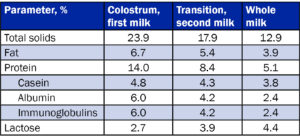
What’s in colostrum?
 By Bethany Dado-Senn, Ph.D., Vita Plus dairy calf and heifer specialist
By Bethany Dado-Senn, Ph.D., Vita Plus dairy calf and heifer specialist
When a calf consultant talks about the importance of colostrum, it’s reminiscent of the “eat vegetables” lecture from the doctor or the “floss daily” reminder from the dentist; these tasks are important for our health, but it’s not always clear why.
Let’s take a closer look at the wide variety of high-value colostral nutrients and non-nutritive factors to understand the “why” behind colostrum feeding.
1. Nutrients: Colostrum is a rich source of essential nutrients, including proteins, fats, vitamins (A, D, E and B complex) and minerals (calcium, magnesium and zinc). Most colostrum nutrients, with the exception of lactose, decrease rapidly in the transition from colostrum to whole milk. Elevated levels of fat and protein can contribute to body temperature regulation and even calf growth if fed for multiple days.

2. Immunoglobulins (Igs): Immunoglobulins are antibody proteins that recognize and bind to pathogens to destroy them. In dairy cattle, Igs cannot be transferred through the placenta and thus are solely available through colostrum as the primary source of passive immunity until the calf’s own immune system matures. Sources include IgG (85-90%), IgM (7%), IgA (5%), and IgE (<3%) that bind bacteria, viruses, and parasites.
3. Leukocytes: Maternal white blood cells, including macrophages and lymphocytes, are present in colostrum to promote active immunity. Research shows calves fed colostrum with maternal leukocytes can activate cell-mediated immunity a whole two weeks earlier compared with calves fed leukocyte-free milk, though improvements in calf disease have not yet been reported. Importantly, pasteurizing, freezing, or pooling colostrum destroys or decreases the effectiveness of the maternal leukocytes.
4. Growth factors: Colostral growth factors include growth hormone, insulin, insulin-like growth factors (IGF-1, IGF-2), and transforming growth factor beta (TGFβ). These play crucial roles in tissue growth, development and repair. For example, IGF-1 and IGF-2 stimulate gut mucosal growth, enzyme secretion, and villus size, which enhances gut absorption and glucose uptake.
5. Cytokines: Colostrum contains cytokines like interleukin 1 beta (IL1β) and tumor necrosis factor alpha (TNFα), signaling molecules that stimulate and mediate the immune response and inflammation.
6. Antimicrobial factors: Lactoferrin is an antimicrobial protein that inhibits the growth of bacteria in the gut. Lysozyme is an enzyme in colostrum that breaks down bacterial cell walls.
7. Oligosaccharides: Complex carbohydrates, including oligosaccharides, are present in colostrum as potent prebiotics. They nourish beneficial gut bacteria and promote a healthy gut microbiome through the competitive binding of pathogens in the intestines.
8. MicroRNAs: These short, non-coding RNAs may serve as a conduit of genetic “conversation” between dam and offspring, potentially contributing to the intestinal epithelium growth and development in the gut.
9. Bacteria: For its beneficial factors, nutrient-rich colostrum also can grow blooms of bacterial pathogens. Sanitary harvest, prompt feeding or cooling, and heat-treating are solutions to minimize bacterial presence.
With its complexity of nutritional and immune-supporting factors, no other liquid can quite compare with the power of colostrum.
Just like eating your vegetables and flossing your teeth, maintaining a solid colostrum program may take dedication, but pays dividends overall. Calves that meet colostrum volume, timing, and quality benchmarks should see short- and long-term benefits in performance, including elevated rates of gain, greater disease protection, improved fertility, and increased first- and second-lactation milk yields.
| Category: |
Calf and heifer nutrition Colostrum management Starting Strong - Calf Care |

